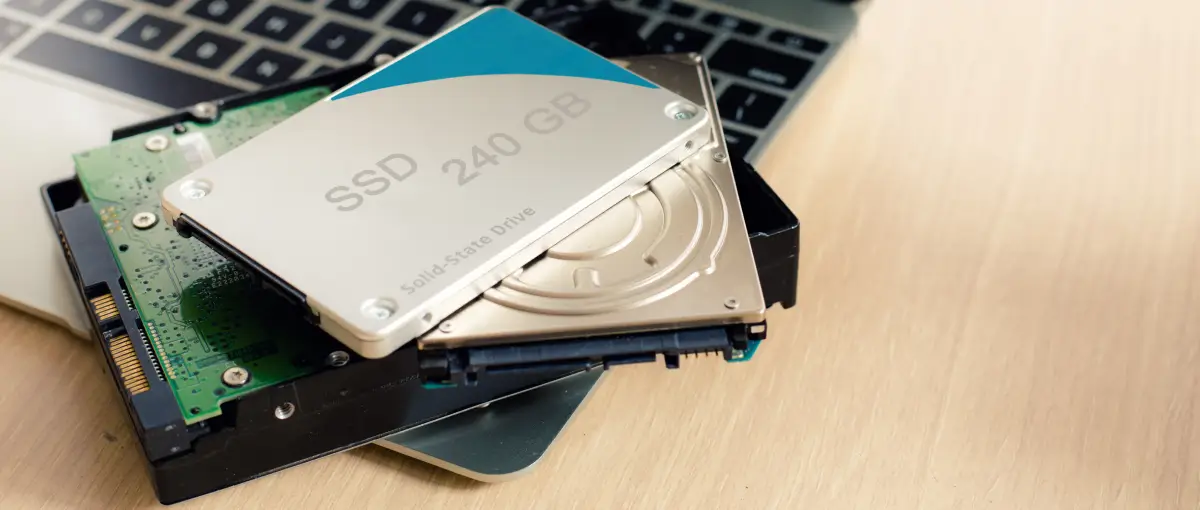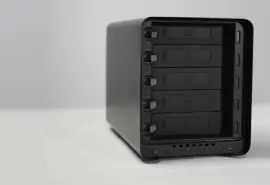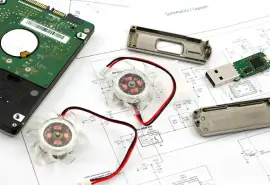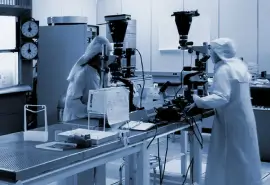Needing to recover deleted files is never pleasant. Data loss is often frustrating and stressful, and most do not understand that the odds of recovering deleted data depend on the device. Though solid-state drives (SSDs) and hard disk drives (HDDs) are the most popular storage media, the two technologies differ. Secure Data Recovery, the experts in RAID, SSD, and hard drive recovery, explain each device’s differences and unique challenges.
Common Causes of Data Loss for SSDs and HDDs
Despite technological differences, SSDs and HDDs often have similar causes of data loss. Common data loss scenarios include failed components, damage from foreign substances or power fluctuations, corruption from a malware or ransomware attack, and human error, including accidental deletion or formatting.
Yet, even in identical situations, recovering inaccessible or deleted data from an SSD requires different tools and techniques than restoring lost files on an HDD due to their disparate designs.
A Primer on SSD and HDD Technologies
While HDDs have been the dominant device since the 1960s, SSDs have gained a significant share of the storage market over the past couple of decades.
The following comparison summarizes the architecture of the devices, their respective advantages, and ideal usage.
SSD Technology
Solid-state drives store digital data in memory cells.
From a mechanical perspective, SSDs are simple. The drives do not contain moving parts. Instead, SSDs have flash memory chips, a controller that manages storage and retrieval, a printed circuit board (PCB) that connects all electronic components, and sometimes a cache for quicker operations.
Flash storage is the foundation of an SSD. The drive stores bits of digital data in memory chips. Those chips have many hierarchical memory cells with NAND logic gates. Each NAND logic gate can have different charges. Altering the charge edits the stored data. In terms of reading data, a charged cell signifies a 1. An uncharged cell represents a 0. Flash memory cells are an example of non-volatile or persistent storage, meaning they retain data without power. (Note: Some studies suggest that NAND flash memory cells lose their charge after a year inside an unpowered system. Periodically connect the device to avoid a complete discharge.)
Upon saving a file, the SSD’s controller distributes data across the device’s cells. When it receives a read request, the controller translates the digital signals to usable data, allowing users to access saved files promptly. In addition, the controller performs other processes, including error correction, wear leveling, and garbage collection.
None of that would be possible without the PCB. The PCB provides a platform for mounting electronic components to the SSD, ensures data can flow between its internals, and communicates with the host computer.
Storage manufacturers have pursued multiple development paths to include denser cells that can hold more data. One method for achieving more storage space involves fitting more bits into each cell. Most of the earliest SSDs had a single-level cell (SLC). That meant each cell held a single bit of data.
A few years later, designers transitioned toward multi-level cells (MLC). As the name suggests, a MLC features two bits of data per cell. Over time, engineers incorporated triple-level cells (TLC) and quad-level cells (QLC) into SSDs.
While each of these technologies increased SSD capacities, there are other considerations. SLC SSDs are the fastest and most reliable but expensive and store less data. MLC SSDs are more affordable and still offer performance benefits. TLC SSDs are an efficient option for many consumer computers. QLC SSDs are perfect for storing massive amounts of data.
Alongside those advancements, manufacturers have developed 3D NAND technologies. SSDs with 3D NAND have vertical stacks of flash memory cells, creating a three-dimensional structure compared to their planar counterparts.
SSDs with even higher capacities will be released as the miniaturization of semiconductors continues.
Overall, SDDs have entrenched themselves as one of the most popular computer peripherals. These drives have higher transfer speeds, lower access times, increased fault tolerance, and decreased power consumption. For those reasons, it is now rare for desktops or laptops to have an HDD as the boot device. However, the improved performance comes with smaller capacities and bigger price tags.
HDD Technology
Hard disk drives are electromechanical devices that store digital data on magnetic platters.
Unlike SSDs, HDDs have several mechanical components that facilitate data storage and retrieval. Some fundamental mechanical components include platters containing raw data, an actuator arm that positions read/write heads over the appropriate track, and motors that provide power to each part. Despite their moving parts, HDDs also have PCBs with multiple controllers that manage operations and components that regulate the flow of electrical current throughout the drive. These electrical currents produce the magnetic interactions responsible for storing data.
Though HDDs have been around for over 60 years, manufacturers have continued to update the device. These changes range from including more platters and better materials to introducing new recording technologies. Each change has pushed the boundaries of HDD performance.
However, given the moving parts in a compact case and the speed of spinning platters, HDDs remain susceptible to mechanical failure and physical damage. To increase their resistance to sudden impacts and vibrations, modern HDDs feature a parking ramp for inactive read/write heads and bearings that enable smoother rotation and reduce friction.
The science behind hard drives is remarkable.
Pundits have been predicting that HDDs will become obsolete for decades. Those predictions ignore one incredible advantage that hard drives have: Larger, cheaper storage. As of 2023, HDDs still store most of the world’s data despite the growing number of SSD shipments. Storage manufacturers also realize an HDD’s value, with Western Digital, Seagate, and Toshiba announcing plans for commercial hard drives exceeding 40 TB before 2030.
Comparing SSDs and HDDs (September 2023)
| Comparison | SSD | HDD |
|---|---|---|
| Storage Medium | NAND Flash Chips | Magnetic Platters |
| Price Per GB | Higher | Lower |
| Common Commercial Storage Capacity | Around 4 TB | Around 20 TB |
| Transfer Speed | Much Higher | Much Lower |
| Access Speed | Much Higher | Much Lower |
| Power Consumption | Lower | Higher |
| Noise Level | 0 dB | 20-40 dB |
| Weight | Lighter | Heavier |
| Physical Durability | More Durable | Less Durable |
| Physical Size | 2.5-inch | 2.5-inch or 3.5-inch |
| Media Lifespan | Shorter | Longer |
Recovering Deleted Data From SSDs
Despite their reputation as superior storage devices, SSDs have a significant drawback:
NAND storage chips have a finite number of writes. After exhaustion, the SSD can no longer save data.
Users should consult their device’s specification sheet. Most manufacturer warranties cover a period of time and a specified amount of recorded data, known as the total bytes written (TBW). The TBW rating varies based on the SSD model and whether it has SLC, MLC, TLC, or QLC technologies. Monitoring TBW can help inform SSD replacement.
Once cells start to degrade, the risk of failure rises, and recovering data from an SSD can be complicated.
And that does not even account for the complexities of recovering deleted files from an SSD.
SSDs have two processes that affect recovering deleted data. To maximize its limited program/erase cycles, designers implemented wear leveling algorithms into SSDs. Wear leveling provides an even distribution of data across the device’s memory cells. The technique prevents specific cells from wearing faster than others and extends the SSD’s lifespan. As such, wear leveling is an ongoing exercise. The SSD never stops relocating data from degrading blocks to less-used ones.
For best results, SSDs must partner wear leveling with garbage collection. Garbage collection is a background process that manages and reclaims storage space within the SSD’s memory cells. When wear leveling algorithms move valid data from a worn-out cell, garbage collection mechanisms remove the fragmented or invalid data. The integrated combination of wear leveling and garbage collection consolidates data, mitigates degradation, and optimizes performance.
The TRIM command is related to the garbage collection process and SSD maintenance, and it is the main obstacle to recovering deleted data.
When users delete data on an SSD, their operating system issues the TRIM command to the device’s controller. At that point, the SSD controller marks the data as invalid and erases it during garbage collection. The TRIM command eliminates the need to relocate pages from a block, which improves the SSD’s write performance in the long term.
Recovering deleted data from an SSD is almost impossible unless users disable TRIM in their command-line interpreter beforehand. In some cases of accidental deletion, immediately powering down and disconnecting the SSD can prevent the TRIM command from firing and preserve stored data.
SSD data recovery is challenging even in ideal circumstances. It requires specialized hardware, software, and expertise. We have dealt with thousands of failed SSDs at Secure Data Recovery, from replacing damaged components to reconstructing the translation table. Despite that, we have maintained a 96% success rate.
Recovering Deleted Data From HDDs
Recovering deleted files from an HDD is easier than an SSD, given how the device manages and stores data. For starters, HDDs have more storage space. HDDs also benefit from a storage medium that does not degrade over time. As a result, HDDs have more lenient data management operations. They do not adhere to erase-before-write processes or come with a TRIM command.
HDDs do not wipe existing data from platters after deletion. Instead, the HDD’s file system marks those clusters and sectors as available for reuse. Therefore, the hard drive retains deleted data in unallocated space until overwritten, and engineers can often access it.
To restore deleted data on an HDD, technicians scan the entire disk for file signatures. Engineers search for these signatures in unallocated space, piece together each file fragment, and recreate the original data.
More complex cases could require advanced data recovery tools and techniques like file carving. The method bypasses damaged or missing file systems and uncovers patterns based on the content and structure of the raw data. Deleted data also carries the risk of significant corruption. Repairing corrupted files might be required. These conditions are especially likely for ransomware data recovery.
While some situations demand expertise, other cases could benefit from data recovery software. Software can be a viable alternative for permanently deleted data. Users who recently emptied their Recycle Bin on a Windows computer can usually restore data using software. In addition, data recovery software can retrieve older files as long as the HDD does not overwrite the lost data.
Our proprietary software, SecureRecovery for Windows, gives users the best chance to recover deleted data from a hard drive. Before scanning, it assesses whether a software recovery is safe. After a quick search or deep scan, SecureRecovery provides a free preview of recoverable files so users understand what can be salvaged before purchasing a license.
Do not save the software to the hard drive that suffered data loss. Doing so jeopardizes the deleted files.
Recovering deleted data from an HDD is within reach.
Professional hard drive recovery can typically return deleted or otherwise inaccessible files. At Secure Data Recovery, we offer a free diagnostic and no-obligation quote as part of our services. Our team has seen it all since 2007 and continues to provide comprehensive data loss solutions.
Deleted Data Recovery
Successfully recovering deleted data from one of these storage devices depends on numerous factors. SSDs are unforgiving when it comes to restoring lost files, given their design. While retrieving deleted data on an HDD is more straightforward, the device could still overwrite the files. In each case, a timely response is essential.
Do not give up hope if previous attempts at deleted data recovery have failed.
We have seen every deletion scenario and resolved thousands of these situations, including cases that other services declared unrecoverable, reuniting customers with millions of important files and priceless memories.
Sudden data loss does not have to be permanent. Trust the data recovery experts when you need it most, with the most industry-specific certifications and a “No Data, No Recovery Fee” guarantee. You get your data back, or pay nothing.
Call us at 800-388-1266 or visit one of our convenient locations to speak with a representative and start a case.






